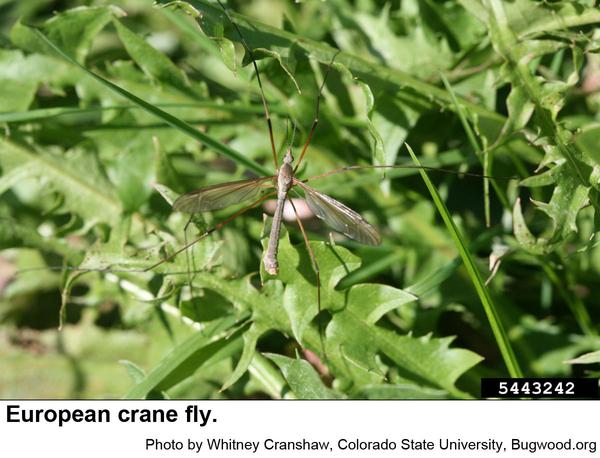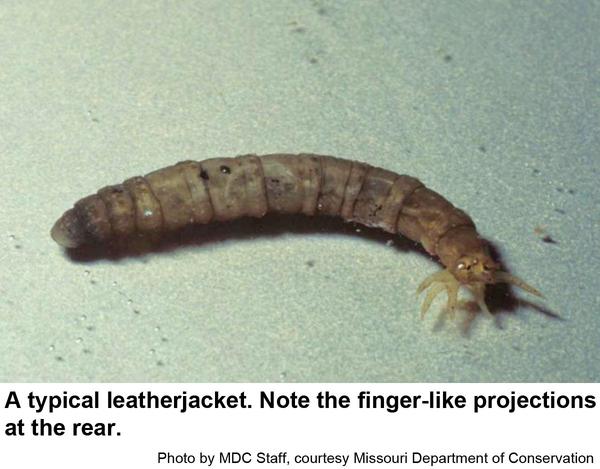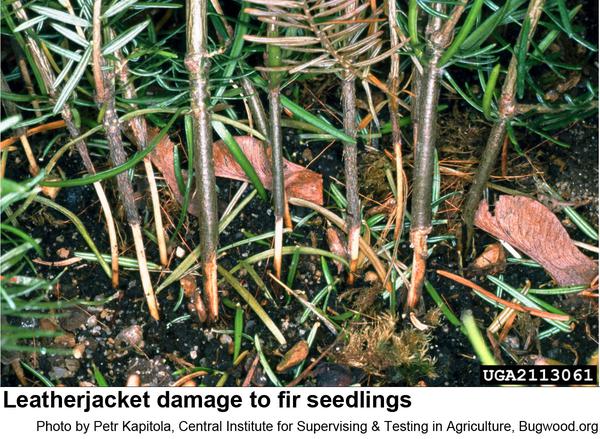Description and Biology
Crane flies are also called daddy-long-legs or even mosquito hawks. We have hundreds of crane fly species in North Carolina.Many resemble giant mutant mosquitoes from Three Mile Island. The wingspan is about 11/2 inches. The legs are very long and fragile and are easily broken off. Even though crane flies have a short proboscis, they are harmless to humans. Some crane flies feed on plant nectar, and it is thought that some crane flies do not feed at all. Maggots of crane flies called leatherjackets because of their tough skin that resembles leather. Leatherjackets in the genus Limonia are scavengers and are usually found in highly organic soils where they feed on decaying organic matter. Leatherjackets in the genus Tipula sometimes feed on the roots of the seedlings and are of some economic concern. Some species of leatherjackets feed on hapless grubs and worms. All are relatively slender grubs with a noticeable head. Many species have a ring of finger-like projections around the other end. The pupae are dark, relatively slender. When the pupae are mature they wriggle up to protrude above the soil surface. The pupae and pupal skins resemble short, dark, gray twigs. Most crane flies lay their eggs in soil, especially cool, moist soil. Newly hatched crane fly larvae (leatherjackets) spend the summer on or below the soil surface as they feed on decaying organic matter and tender plant roots. In compost piles, they often occur on the soil surface below the pile of decaying vegetation. They are sometimes found under layers of decomposing leaves in wet locations. When mature, leatherjackets pupate, and by end of August or early September, new crane flies emerge, mate, and lay up to 300 eggs within the first 24 hours. Once the eggs hatch, new leatherjackets feed throughout the fall and following spring. Crane flies have one or two generations per year. Leatherjackets tend to do the most harm in cool, wet springs as they feed on roots, stems, and even leaves. Crane flies are often abundant in the fall in gardens, pastures, and meadows.
Host Plants
Leatherjackets have been reported damaging cereals, fir seedlings, flower seedlings, legumes, nursery stock, peppermint, tobacco seedlings, and turfgrasses. Turfgrasses may receive additional damage by birds and skunks uprooting plants as they forage for leatherjackets.
Residential Recommendations
Insecticides containing carbaryl, imidacloprid, and trichlorfon have been cited for leatherjacket control. These insecticides have formulations that are labeled for residential landscape use. They should be available in most big box stores, plant centers, and retail nurseries. The active ingredient of any pesticide is usually toward the bottom of the front label and usually in very small type. Be sure to follow the directions for safe use also found on the label.
Other Resources
- Crane Fly. Drees, B. M. No Date. Field Guide to Common Texas Insects. Texas A&M AgriLife Extension.
- European Crane Fly. Anonymous. 2019. New York Invasive Species (IS) Information.
- Extension Plant Pathology Publications and Factsheets
- Horticultural Science Publications
- North Carolina Agricultural Chemicals Manual
For assistance with a specific problem, contact your local Cooperative Extension Center.
This Factsheet has not been peer reviewed.
Publication date: June 20, 2020
Revised: June 20, 2020
Recommendations for the use of agricultural chemicals are included in this publication as a convenience to the reader. The use of brand names and any mention or listing of commercial products or services in this publication does not imply endorsement by NC State University or N.C. A&T State University nor discrimination against similar products or services not mentioned. Individuals who use agricultural chemicals are responsible for ensuring that the intended use complies with current regulations and conforms to the product label. Be sure to obtain current information about usage regulations and examine a current product label before applying any chemical. For assistance, contact your local N.C. Cooperative Extension county center.
N.C. Cooperative Extension prohibits discrimination and harassment regardless of age, color, disability, family and marital status, gender identity, national origin, political beliefs, race, religion, sex (including pregnancy), sexual orientation and veteran status.




